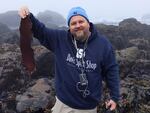
I found the prized "Turkish towel" that I had been looking for.
Eugene Kim
It’s cool and foggy when I arrive at Schoolhouse Beach — a typical morning on this part of California’s Pacific Coast.
It's these low temperatures that attract most visitors hoping to escape the summer heat farther inland. But today's extreme low tide has attracted the group gathered down on the beach. About 15 students are here to learn how to identify and harvest seaweed.
Foraging has grown into a movement over the last few years, including from your local ocean where it's now peak seaweed season.
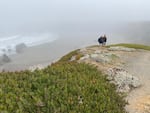
Schoolhouse Beach is an escape from the heat elsewhere.
Elissa Rumsey
Our leader of this 3-hour class is Heidi Herrmann, who runs a company called Strong Arm Farm and guides public tours like this one through Forage SF.
"There's actually 640 different species [of seaweed] here on the California coast," she tells us before we dive in. "They're all edible, too, and that's kind of the big, fun lesson of today is just let's kind of taste as we go along."
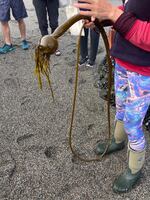
Want some of this bull kelp? You have to be prepared for a taste sensation on this foraging trip.
Chad Campbell
Heidi makes a couple of cuts with her scissors and pops a crunchy, hollow circle of bull kelp into her mouth, as the class chuckles nervously.
But not everything out here is for eating. My wife, Elissa Rumsey, joined me, and her main goal is to find something known as "Turkish towel." I'm told that its rough leaves make a great exfoliant.
First we find plenty of Turkish "washcloth" — a version too small to bother with. But after a few minutes of splashing through shallow tide pools and making my way over and around huge, slippery rocks, I see it: a single leaf of Turkish towel chondracanthus exasperatus. It's about as long as my forearm.
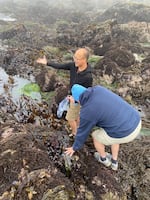
Eugene surveys our options.
Elissa Rumsey
Our fellow forager and friend Eugene Kim drove up from San Francisco to join us for the forage. He was very excited for me.
"Oh! That is the mother lode right there! That is the good stuff! Nice," Eugene exclaimed.
He tells us that most of what he knows about seaweed, he learned from taking Heidi's class last year.
We are here at low tide so we can get to more of "the good stuff" — the bladder wrack, the nori and the kombu; seaweed that just hours before was under water and inaccessible.
You've no doubt seen seaweed washed up on the sand, which is decomposing and bleached by the sun. That's not what we're looking for. We need to get to it while it's still alive and anchored to the rocks — healthy, vibrant and full of nutrients.
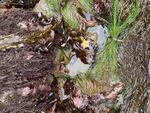
There was an edible bounty on offer.
Chad Campbell
Eugene leads us into that intertidal zone.
"So we're gonna grab this Ziploc bag and we're gonna grab a pair of scissors. And we'll start heading out into the tide," he tells us.
Our first find is bladder wrack, which has lots of little bunches of dark green leaves.
"You'll find this in health food stores," Eugene says. "It's a really good source of iron and iodine as well. You could put 'em in salads, right? Give it a little flavor, a little punch."
Elissa is a fan.
"I like it. It's salty, just a little hint of sea salt," she says after nibbling on a small bunch.
And it's important to do this sustainably, so we only harvest a small portion of each individual plant. Eugene's rule of thumb is no more than 25%. During this part of its lifecycle, the seaweed is still able to regenerate much of what we trim away.
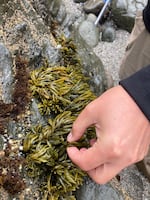
We were careful not to take more than was sustainable.
Chad Campbell
A little farther down the beach we find a huge section of nori, the raw ingredient for sushi wrappers.
"They take this stuff, they dry it out, then they kind of crush it," Eugene explains. "And then they turn them into flat sheets and then they roast it. This is exactly what you would find in any of your sushi places or any Korean restaurant."
We don't recognize every piece of algae clinging to the rocks, but that doesn't stop Eugene. Remember, all 640 species we might find out here are edible. I point to a long, stringy, dark red mass of seaweed hanging from the side of a rock.
"I have no idea what that is. Let's taste some," Eugene exclaims.
After a quick snip and sample he concludes that just because you can eat it, doesn't mean you should eat it.
"This is bitter. It does not look appetizing and I would say it doesn't taste appetizing either," Eugene says.
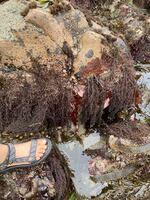
It's peak seaweed season, and the pickings aren't slim. This one was not so delicious, however.
Chad Campbell
Well, they can't all be winners. But trying new things and sharing what you learn has led to some pretty wonderful innovations around the world.
Eugene gives a couple of examples, like how the tomato is integral to what we think of as Italian food, but they didn't have tomatoes before 1492.
He goes on to talk about Korean food.
"Everyone thinks kimchi is spicy and it's got the chili peppers and stuff, which it does," he says. "But chili peppers come from the Americas. And so prior to the 1400s, Korean kimchi did not have chili peppers in it. So I think it's incredible how global the world was even 500 years ago. And how all these things that we think about, like Asian traditional culture, for example, they actually come from right here."
We pack up our bags of seaweed and head home, feeling just a little bit closer to nature and to the rest of the world.
Chad Campbell is a producer with NPR's Morning Edition.
Copyright 2022 NPR. To see more, visit https://www.npr.org.